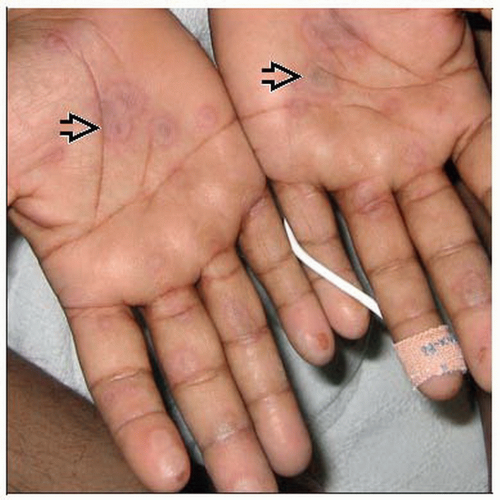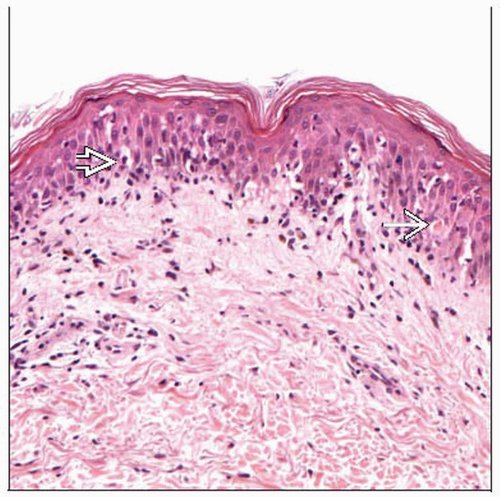Erythema Multiforme and Related Disorders
Julie E. Jackson, MD
Chandra N. Smart, MD
Key Facts
Terminology
EM minor (von Hebra): Typical targetoid skin lesions with mild or no mucous membrane involvement
SJS/TEN: Serious, life-threatening reaction; extensive epidermal necrosis with severe mucous membrane involvement and systemic symptoms
Etiology/Pathogenesis
Fas ligand-mediated apoptosis probably central to development of epidermal necrosis
Microscopic Pathology
EM minor
Orthokeratotic stratum corneum as seen in an acute process
Superficial, sparse perivascular lympho-histiocytic infiltrate with lymphocyte exocytosis
Interface dermatitis consisting of lymphocytes along dermal-epidermal junction with basilar vacuolization
SJS/TEN
Well-developed lesions display marked keratinocyte necrosis leading to full thickness epidermal necrosis with subepidermal bulla formation
Interface changes and apoptotic keratinocytes can also affect hair follicles and eccrine duct epithelium
Top Differential Diagnoses
Fixed drug eruption
Acute graft vs. host disease
Pityriasis lichenoides et acuta
Phototoxic dermatitis
Connective tissue disease
TERMINOLOGY
Abbreviations
Erythema multiforme minor (EM)
Steven-Johnson syndrome/toxic epidermal necrolysis (SJS/TEN)
Synonyms
Erythema multiforme minor
Erythema multiforme von Hebra, herpes simplex-associated erythema multiforme
Steven-Johnson syndrome/toxic epidermal necrolysis
Lyell syndrome
Definitions
EM minor (von Hebra): Acute, self-limited, immune-mediated reaction to infections or drugs consisting of typical targetoid skin lesions with mild or no mucous membrane involvement
SJS/TEN: Serious, life-threatening reaction often to medications consisting of atypical targetoid lesions that evolve to extensive epidermal necrosis and epidermal sloughing with severe mucous membrane involvement and systemic symptoms
SJS: 10% of total body surface area affected
TEN: 30% of total body surface affected
ETIOLOGY/PATHOGENESIS
Infectious Agents (Major Causes of EM Minor)
Herpes simplex virus types 1 and 2
Mycoplasma pneumoniae
Drug Mediated (Major Causes of SJS/TEN)
Sulfonamides
Antibiotics
Aminopenicillins, cephalosporins, quinolones
Anticonvulsants
Phenytoin, barbiturates, carbamazepine
Nonsteroidal anti-inflammatory medications
Phenylbutazone, oxyphenbutazone, isoxicam, piroxicam
Other Associations
Environmental factors, radiocontrast media, connective tissue disease, neoplasms, pregnancy, vaccinations
Pathogenesis of SJS/TEN
Fas ligand-mediated apoptosis is probably central to development of epidermal necrosis








